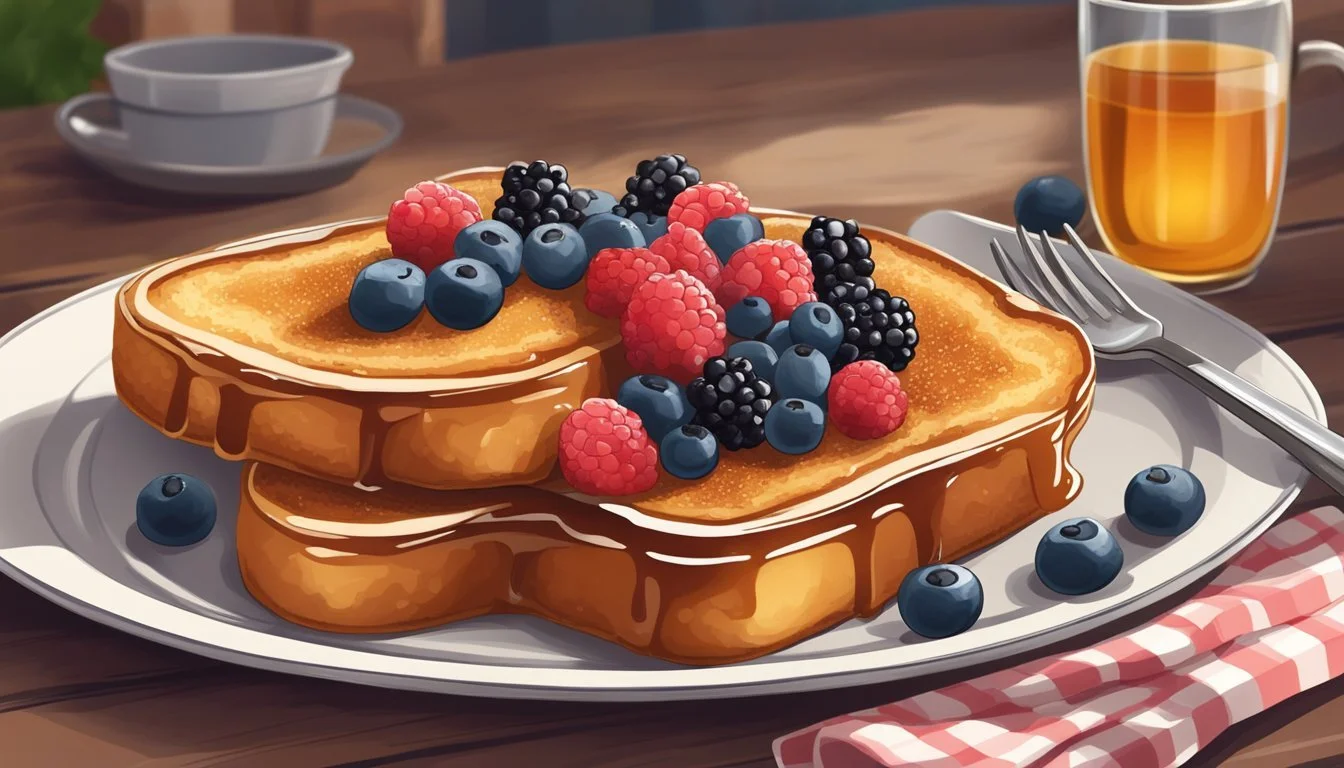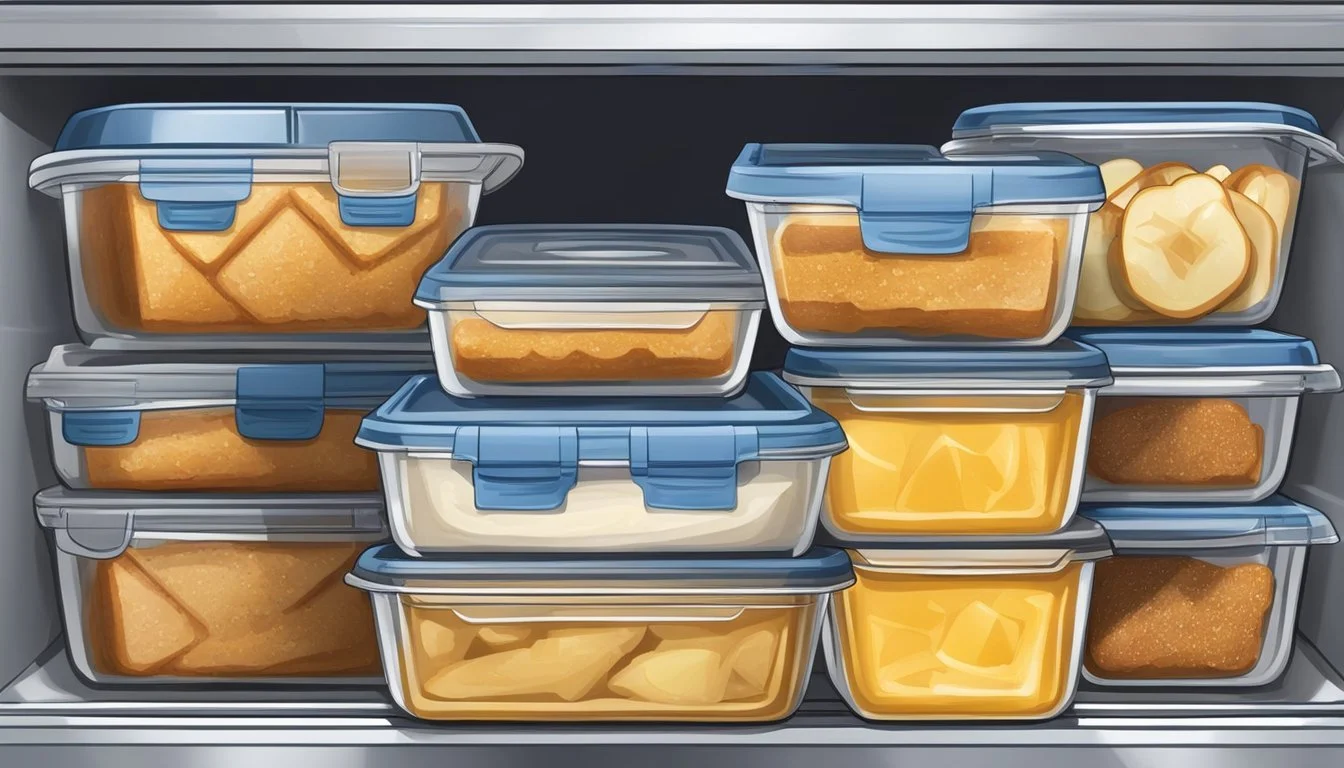How Long Does Gluten-Free French Toast Last?
Storage Tips and Best Practices
Gluten-free French toast provides a delicious breakfast option for those avoiding gluten. It's easy to make and can be enjoyed fresh or stored for later meals. But when preparing this dish, a key question arises: How long does gluten-free French toast last?
In the refrigerator, gluten-free French toast should be consumed within 3 to 4 days. Ensure it is stored in an airtight container to maintain its texture and flavor. For longer storage, freezing is a fantastic option. Properly wrapped in plastic wrap and stored in a freezer-safe bag, gluten-free French toast can last up to a month.
Whether enjoying it fresh off the skillet or reheating leftovers, maintaining the right storage practices will keep this breakfast staple tasty and safe to eat. With its ability to be easily stored and reheated, gluten-free French toast remains a convenient and tasty option for anyone, anytime.
Understanding Gluten-Free French Toast
Gluten-free French toast relies on using gluten-free bread to accommodate those with celiac disease or gluten sensitivities. It's crucial to choose the right type of gluten-free bread to achieve the desired texture and taste in the final dish.
What Makes French Toast Gluten-Free
To make French toast gluten-free, traditional wheat-based bread is replaced with gluten-free bread. This ensures that the dish is safe for individuals with gluten intolerance or celiac disease.
Gluten-free bread options vary widely in texture and flavor. Popular brands include Udi's and Canyon Bakehouse, which offer a soft and slightly sweet taste suitable for French toast.
Mixing the right balance of eggs, milk, and spices like cinnamon and vanilla is crucial. This combination helps to enhance the flavor while maintaining the correct consistency.
Selecting the Right Gluten-Free Bread
Choosing the correct gluten-free bread is essential for the success of gluten-free French toast. Some brands, such as Udi's or Canyon Bakehouse, offer sliced bread that works well for this dish.
Look for bread that is sturdy enough to hold up when soaked in the egg mixture. Some gluten-free breads can be crumbly, which means they might fall apart during cooking.
For best results, opt for slightly stale bread. It absorbs the egg mixture better, resulting in a crispy exterior and a soft interior.
Essential Ingredients and Substitutes
Creating a delicious gluten-free French toast requires the right combination of ingredients. This section highlights the key components of the batter and discusses various dairy and non-dairy options.
Key Ingredients for French Toast Batter
Eggs form the backbone of the French toast batter. They bind the ingredients together and add richness, making them irreplaceable for authentic texture and flavor.
Milk is another crucial component. It helps achieve a creamy consistency in the batter. Regular cow's milk works well, but those who are lactose intolerant can consider alternatives.
Bread is central to French toast. Gluten-free options are widely available, and choosing a type that holds well during cooking is vital.
A blend of cinnamon and a pinch of salt enhances flavor. Pure vanilla extract adds depth and warmth to the mix.
Essential ingredients include:
Eggs
Milk (or substitutes)
Gluten-free bread
Cinnamon
Pure vanilla extract
Pinch of salt
Together, they create a lush and satisfying French toast experience.
Dairy and Non-Dairy Variations
For those preferring or needing to avoid dairy, several non-dairy milk options can be substituted in the French toast batter.
Almond milk offers a slightly nutty flavor, which pairs well with the spices in the batter. Cashew milk provides a creamier texture akin to regular milk. Oat milk is another excellent choice, especially for those with nut allergies.
For cooking, butter is the traditional fat, but dairy-free margarine or coconut oil can be substituted without sacrificing much flavor. These alternatives work well in a nonstick skillet.
Some suitable non-dairy substitutes are:
Almond milk
Cashew milk
Oat milk
Dairy-free margarine
Coconut oil
These options make it possible to enjoy delicious gluten-free French toast while accommodating dietary restrictions.
Preparing and Cooking Gluten-Free French Toast
Creating the perfect gluten-free French toast involves preparing a well-balanced batter and choosing the best cooking method to achieve that golden, crispy outside.
Mixing the Perfect Batter
Start by beating eggs in a shallow dish. For a dairy-free option, replace regular milk with unsweetened almond milk. Add sugar, cinnamon, vanilla extract, and a pinch of salt to the eggs. This mixture will coat the gluten-free bread slices evenly.
Whisk everything until it's fully combined, making sure no egg whites are left unbeaten. This step ensures each slice of bread absorbs the flavors uniformly. Adjust spices to taste, adding nutmeg or allspice if desired.
Skillet Versus Griddle Cooking
Choosing between a skillet and a griddle impacts the cooking process. A nonstick skillet or a cast iron skillet retains heat well and provides a consistent cooking surface. For those making multiple slices, a griddle or electric skillet offers more space and uniform heat distribution.
Heat the skillet or griddle over medium heat. Add butter or oil, ensuring the surface is well-greased but not swimming in fat. The pan or griddle should be hot enough that a drop of water sizzles on contact.
Achieving the Golden Crispness
To cook, dip slices of gluten-free bread into the batter, ensuring they are fully submerged. Let each slice soak briefly, absorbing the mixture. Transfer the bread to the hot skillet or griddle.
Cook until the underside is golden brown, usually around 3 minutes. Use a rubber spatula to gently flip the bread, cooking the other side for an additional 3 minutes. Adjust heat if the bread browns too quickly or too slowly.
To keep the French toast from getting soggy, place it in a warm oven until ready to serve. This step helps maintain the desired crispness and keeps it warm without drying it out.
Serving and Toppings
When it comes to serving gluten-free French toast, the options for toppings are both traditional and inventive, adding variety and flavor to every bite. Pairing it with complementary sides can create a balanced and satisfying meal.
Classic and Inventive Toppings
Classic toppings like maple syrup and powdered sugar never fail to enhance the flavor of French toast. Adding a dollop of butter on top while the toast is still warm allows it to melt and seep into the bread, enriching the taste.
For those who enjoy fruity flavors, berries such as strawberries, blueberries, and raspberries make excellent options. They add a fresh, slightly tart contrast to the richness of the French toast.
More creative toppings can include a drizzle of honey or a sprinkling of cinnamon-sugar mix. Fresh fruit like sliced bananas, apples, or pears can also be delightful. For a decadent twist, consider adding a smear of nut butter or a spoonful of yogurt.
Serving Suggestions for a Complete Meal
To turn gluten-free French toast into a complete meal, think about adding protein and vegetables on the side. Crispy bacon or sausages are popular choices that pair well with the sweet and savory notes of the French toast. Scrambled eggs or a vegetable omelette can offer a nutritious balance.
A fresh fruit salad can complement the meal, adding freshness and a variety of textures. Consider serving the French toast with a glass of orange juice or a cup of coffee for a classic breakfast experience.
For a more filling option, serve the French toast alongside a slice of gluten-free banana bread. This not only adds variety but also ensures that everyone at the table finds something to enjoy.
Storing and Shelf Life of Gluten-Free French Toast
Proper storage of gluten-free French toast helps maintain its freshness and flavor. Learn the best practices for refrigerating and freezing your leftovers to extend their shelf life.
Refrigeration Best Practices
Storing gluten-free French toast in the refrigerator helps keep it fresh for a few days. After cooking, allow the French toast to cool completely. Store it in an airtight container or wrap it tightly in plastic wrap to retain moisture and prevent it from drying out.
Typically, refrigerated gluten-free French toast can last up to 3-4 days. When ready to eat, reheat it gently in a microwave or on a skillet over low heat to preserve its texture. Avoid leaving French toast at room temperature for more than two hours to minimize the risk of bacteria growth.
Can You Freeze Gluten-Free French Toast?
Yes, freezing gluten-free French toast is a viable option for longer storage. Cool the toast completely before placing it in the freezer. To prevent sticking, layer each piece with parchment paper and store them in a zip-top freezer bag or an airtight container. Properly stored, it can last for up to 1-2 months in the freezer.
When reheating frozen French toast, it is best to thaw it overnight in the refrigerator first. Reheat in a preheated oven at 350°F (175°C) for about 10 minutes, or until heated through. This method helps maintain the toast's crispness and flavor. Avoid reheating directly from frozen in a microwave as it can become soggy.
Nutritional Information
Gluten-free French toast offers unique nutritional aspects, especially when considering caloric intake and ingredient choices. It is a tasty option for breakfast, particularly for those on dairy-free diets.
Caloric Content and Health Considerations
The caloric content of gluten-free French toast depends on the ingredients used. Typically, one slice prepared with eggs, gluten-free bread, and almond milk has around 150-200 calories.
Sugar and cinnamon are common additions that can slightly increase the calorie count.
Gluten-free bread may have different caloric values compared to regular bread, but this variation is often minimal. Selecting ingredients like dairy-free milk can help reduce overall fat and calorie content, making it a healthier choice for individuals with lactose intolerance.
Alternative Gluten-Free Breakfast Recipes
When seeking gluten-free breakfast options, there are several recipes that provide both variety and nutrition. Among the most popular and satisfying options are gluten-free pancakes, waffles, and innovative breakfast casseroles.
Gluten-Free Pancakes and Waffles
Gluten-free pancakes and waffles are versatile and easy to make. They can be prepared using gluten-free flour blends, which typically include rice flour, tapioca flour, and potato starch.
To enhance the flavor, you can add ingredients like vanilla extract, cinnamon, and fruit pieces such as blueberries or bananas.
Many recipes suggest:
Baking powder as a leavening agent to ensure fluffiness.
Eggs and milk (or dairy-free milk alternatives) to bind the ingredients.
Oil or melted butter for moisture.
Cooking tips:
For pancakes, use a nonstick skillet over medium heat.
For waffles, preheat the waffle iron and cook until golden brown.
Innovative Gluten-Free Breakfast Casseroles
Innovative gluten-free breakfast casseroles combine a variety of ingredients for a hearty meal. These casseroles can include layers of vegetables, proteins, and gluten-free grains like quinoa or rice.
Key components:
Vegetables: Bell peppers, spinach, mushrooms, and zucchini.
Protein: Eggs, turkey sausage, or tofu for a vegetarian option.
Cheese: Regular or dairy-free cheese can be added for richness.
Spices: Salt, pepper, and herbs like thyme or parsley enhance the overall flavor.
Assembly involves layering the ingredients in a baking dish, then pouring an egg mixture over the top to bind everything together. Bake until firm and golden brown. These casseroles are great for meal prep and can be refrigerated for quick, convenient breakfasts throughout the week.
Tips and Tricks for Perfect Gluten-Free French Toast
Making gluten-free French toast requires attention to detail. Using the right equipment and techniques will ensure your dish is both fluffy and moist.
Cooking Techniques and Equipment
Cooking gluten-free French toast effectively requires specific tools and methods. A nonstick skillet is ideal to prevent sticking and ensure even cooking.
A rubber spatula helps with gentle flipping, preserving the bread's structure.
Cooking at medium heat is crucial. High heat risks burning, while low heat can make the toast soggy.
Preheat the pan and melt butter before adding the bread to prevent sticking.
Use a timer to ensure the bread cooks for approximately 3 minutes per side until golden brown.
Avoid prolonged soaking of the bread to maintain a firm texture.
Creating Fluffy and Moist French Toast
Achieving fluffiness and moisture in gluten-free French toast depends on ingredient selection and preparation.
Use slightly stale, homemade gluten-free bread. Fresh bread may become too soft.
Whisk a custard mixture with eggs, milk (or a dairy-free alternative), sugar, and spices until smooth.
Tapioca starch can be added to the custard for extra fluffiness.
Dip the bread briefly in the custard to coat it without oversaturation.
Ensure the custard mixture clings to the bread for a moist interior. Cooking on medium heat seals the moisture and maintains a crispy exterior.
Serve immediately for best texture and taste.
Social Sharing and Community
Engaging in social sharing and being part of a gluten-free community can enhance one’s culinary experience and provide support. Platforms like Facebook, Pinterest, and Instagram offer unique ways to connect and share recipes.
Engaging with Gluten-Free Communities Online
Facebook is a valuable platform for joining dedicated gluten-free groups. These communities share tips, recipes, and provide emotional support. Users frequently post about the best ways to store and enjoy gluten-free French toast.
Pinterest serves as a visual library for gluten-free recipe ideas. Here, users can discover creative ways to prepare and preserve gluten-free French toast. Visual pinboards offer inspiration and practical advice.
Instagram is perfect for sharing mouthwatering photos and videos. Hashtags like #glutenfreefrenchtoast help enthusiasts connect and exchange ideas. Sharing personal creations can inspire others and receive feedback.









